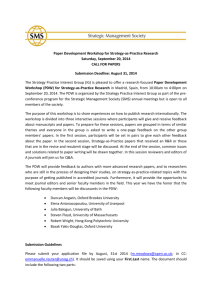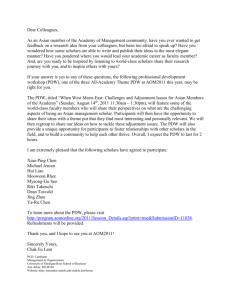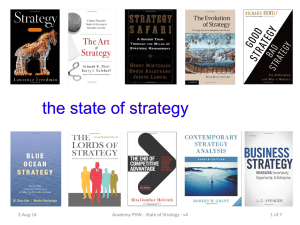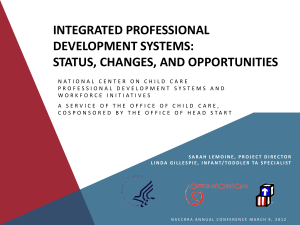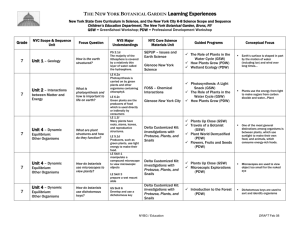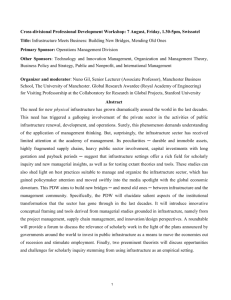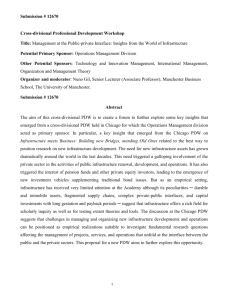A GUIDE FOR CREATING AND MANAGING A GOOD PROFESSIONAL DEVELOPMENT WORKSHOP*
advertisement
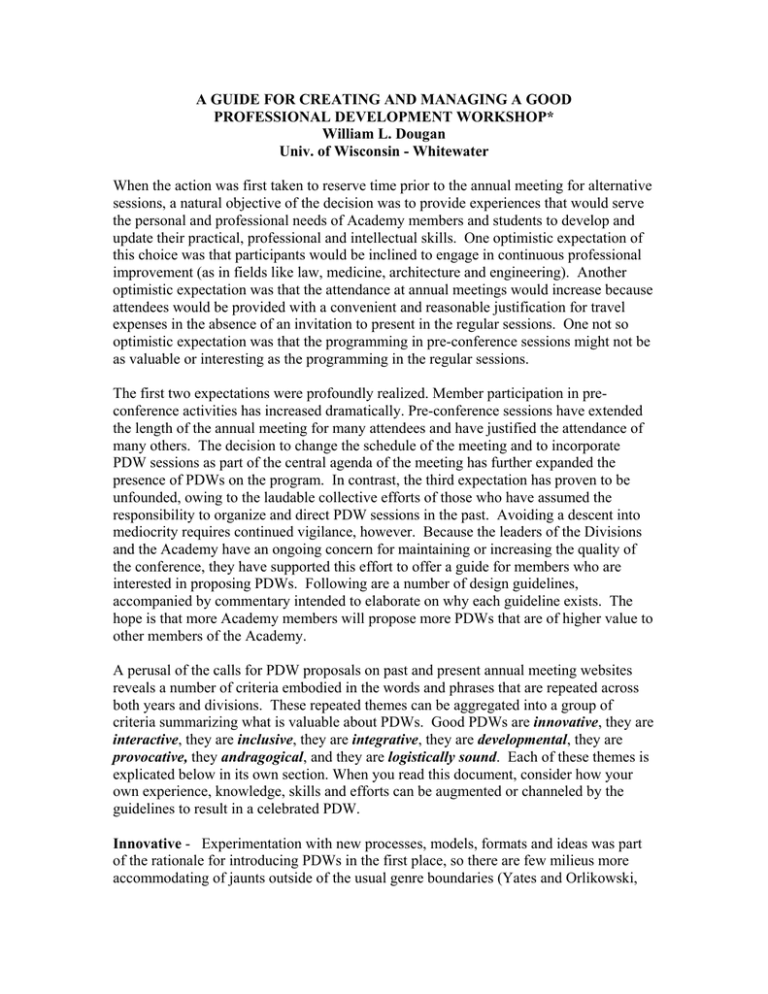
A GUIDE FOR CREATING AND MANAGING A GOOD PROFESSIONAL DEVELOPMENT WORKSHOP* William L. Dougan Univ. of Wisconsin - Whitewater When the action was first taken to reserve time prior to the annual meeting for alternative sessions, a natural objective of the decision was to provide experiences that would serve the personal and professional needs of Academy members and students to develop and update their practical, professional and intellectual skills. One optimistic expectation of this choice was that participants would be inclined to engage in continuous professional improvement (as in fields like law, medicine, architecture and engineering). Another optimistic expectation was that the attendance at annual meetings would increase because attendees would be provided with a convenient and reasonable justification for travel expenses in the absence of an invitation to present in the regular sessions. One not so optimistic expectation was that the programming in pre-conference sessions might not be as valuable or interesting as the programming in the regular sessions. The first two expectations were profoundly realized. Member participation in preconference activities has increased dramatically. Pre-conference sessions have extended the length of the annual meeting for many attendees and have justified the attendance of many others. The decision to change the schedule of the meeting and to incorporate PDW sessions as part of the central agenda of the meeting has further expanded the presence of PDWs on the program. In contrast, the third expectation has proven to be unfounded, owing to the laudable collective efforts of those who have assumed the responsibility to organize and direct PDW sessions in the past. Avoiding a descent into mediocrity requires continued vigilance, however. Because the leaders of the Divisions and the Academy have an ongoing concern for maintaining or increasing the quality of the conference, they have supported this effort to offer a guide for members who are interested in proposing PDWs. Following are a number of design guidelines, accompanied by commentary intended to elaborate on why each guideline exists. The hope is that more Academy members will propose more PDWs that are of higher value to other members of the Academy. A perusal of the calls for PDW proposals on past and present annual meeting websites reveals a number of criteria embodied in the words and phrases that are repeated across both years and divisions. These repeated themes can be aggregated into a group of criteria summarizing what is valuable about PDWs. Good PDWs are innovative, they are interactive, they are inclusive, they are integrative, they are developmental, they are provocative, they andragogical, and they are logistically sound. Each of these themes is explicated below in its own section. When you read this document, consider how your own experience, knowledge, skills and efforts can be augmented or channeled by the guidelines to result in a celebrated PDW. Innovative - Experimentation with new processes, models, formats and ideas was part of the rationale for introducing PDWs in the first place, so there are few milieus more accommodating of jaunts outside of the usual genre boundaries (Yates and Orlikowski, 1992; Orlikowski and Yates, 1994) of Academy sessions. Organizers are encouraged to offer what the regular program cannot and to try things that might not fit elsewhere. PDWs are an opportunity to drop old tools and to create and test new ones (Weick, 1996), in a non-crisis atmosphere. For example, the value of a PDW is often heightened by using new forms of technology (eg. - virtual meeting spaces, digitized video, podcasting, wikis, etc.) and new forms of structure (e.g. - multi-month interaction times, road trips, pre-conference homework, etc.) to solicit the contributions, problems, interests and/or concerns of the participants prior to and after a physical meeting. Norms regarding structure, process time and physical location can be violated for the well-being of the participants, the Divisions and the Academy as a whole. However, the intent is not to stretch boundaries just for the sake of seeing what will happen. Value comes from active engagement of participants in learning new information, skills, techniques, issues, or questions, and not from participating in something bizarre, unusual or unprecedented. The concern should be to create value for participants in ways that may not be available via other means. Thus, there may be a need to suspend rules and violate norms, but only as a means to the end of serving the needs of stakeholders. Calls for proposals typically identify workshops, town hall meetings, debates, tutorials, panels, tours, roundtable discussions, case studies, debates, invited speakers, tutorials and workout sessions as acceptable formats for PDWs. These forms are suggested because they have served well in the past. It might be useful, however, to incorporate elements of events or collectives that further extend the limits of the social structures and processes typically encountered when the regular conference program is in operation. Innovative proposals could draw on political phenomena (like congresses, guilds, cartels, blogfests, agoras, union halls, cabals, espionage agencies or teach-ins). They could draw on competitive contexts (like regattas, pit stops, sandlot ballgames, adventure races, spelling bees, poetry slams, salons des arts or tribunals). They could draw on collective work projects (like quilting circles, emergency preparedness simulations, barn raisings, investment clubs, wikis, threshing bees, ateliers, fundraisers or feschrifts). They could draw on stylized markets (like trade shows, speed dating, yard sales, farmer’s markets, raffles, music exchange networks, facebooks, celebrity auctions or comedy clubs). They could draw on social events (like raves, luaus, tailgate parties, smart mobs, wakes, block parties, celebrity roasts, reunions, pow-wows, church basements, clambakes or caleighs). They could draw on personal or normative transformations (like revivals, weddings, Chautauquas, self help groups, ordinations or retreats). They could draw on the tourist trade (as with caravans, safaris, festivals, museums, fantasy camps, bicycle tours or climbing expeditions). They could draw on creative enclaves (like kino kabarets, entrepreneurial incubators, jam sessions or improvs). All of these forms have also occurred or persisted because they generate value for participants. Understanding and deploying that functionality to generate value is the essence of a good PDW. An important note is that rote imitation of the models in the previous lists might not be as effective as understanding how the models have served constituents and incorporating those structures, functions and processes into existing or new forms. Interactive - Nearly all PDW chairs call for interactivity. Typically, the effectiveness (and enjoyment) of a session is tied to role expectations that render participants both active and interactive. Research pertaining to the success of adult learners (MacKeracher, 2004; Merriam, 2001; Taylor, K. 2000) and collaborative learning processes (Felder & Brent, 2001) supports this observation. A PDW is valuable when many alternative points of view on topics are offered, compared, discussed, tested and evaluated. Interactivity in sessions implies that conversation is valued more highly than reportage and that the atmosphere of a coffee house is valued more highly than that of a theater or concert hall. It also means that debate and disagreement may be helpful, but that they may not be helpful when they reach the level of confrontation, because confrontation often reduces the level of interaction rather than enhancing it. Participants who have chances to share, debate, reflect, converse, exchange, fraternize, negotiate and/or concur tend to be happier and more satisfied, which leads to further interaction. An example of a successful interactive design is one where participants submit paper drafts or proposals well ahead of the session, and others (including some valued role models) review and critique those submissions with the object of proliferating research products that will benefit everyone. Inclusive – Though some PDWs may limit participation to those with specific divisional memberships, with specific theoretical interests, with specific prior preparation or with specific educational or occupational status, good PDWs usually accommodate and provide value for all types of participants who attend. Successful PDWs reflect concerted efforts on the part of organizers to incorporate the contributions of colleagues from more than one social milieu, invisible college or occupational category. Often, PDWs solicit, incorporate or even showcase the contributions of Ph.D. students, junior faculty and/or international members. Likewise, practitioners from corporations, consultancies, public sector agencies, NGOs, and non-profits will take active and specified roles in the events. For example, it may be valuable for a doctoral student to organize a PDW at a conference as a means of gaining experience for a first foray into classroom teaching. Furthermore, structuring a networking opportunity for others often generates enviable network ties for the organizer. It is important to consider the difference between role and status in the PDW. Good PDWs often incorporate actors of high status, but minimize the distancing effect of that status by creatively designing roles that reduce the barriers accruing from status. An example of this approach is a session that focuses on dissertation development. The object of the session is not fixing problems with existing dissertation proposals, but on framing new research questions that can benefit everyone in the field. Integrative – A concern for integration gives rise to PDWs that foster connections both within and between individuals. A good PDW interweaves communities through the opportunity for special or extended interaction. It bridges divisional lines, international borders, communities of practice, invisible colleges, career stages, occupational categories and/or levels of analysis. The interactions in a good PDW stimulate the crossfertilization that expands thinking, allowing the generation and contemplation of new possibilities. A PDW facilitates the transfer of intellectual or experiential associations that may only occur within specific individuals to larger collectives. For example, the term consortium, which is used in conjunction with regularly-occurring pre-conference activities, implies this integrative agenda. These pre-conference meetings could have been called indoctrinations or orientations or examinations or hazing sessions or training sessions, but these words do not carry the sense of extensive, rich and informal collegial interaction among varied constituents embodied in the word consortium. Debate is best accomplished when it is announced well ahead of time and when the opportunities for criticism are controlled by channeling them in ways that limit the degeneration of discourse into personal attacks or paralyzing impasses. Developmental – The term developmental implies a preference for PDWs that enhance individuals as opposed to distributing standardized solutions. Good PDWs allow participants to exploit their physical proximity at the meetings to build networks, to create and strengthen commonalities of understanding and to clarify common approaches. Good PDWs are also designed to develop collectives (like divisions, firms, schools, initiatives or movements) through developing constituents who provide subsequent accounts of their experiences or who continue their efforts beyond the short term. Good organizers design events where coaching, apprenticeship, experimentation, trade secrets, exploration, co-evolution, idea trading, auditing (as in courses), self-help, ferment, norm creation and prospecting are discussed and/or deployed. The creation or augmentation of professional and personal skills in perception, analysis, diagnosis, design, organization, instrumentation, documentation, rhetoric, communication, negotiation, funds generation are welcomed outcomes of PDWs. Examples of skills that might be addressed include how to outline a research paper, how to write the methods section of a paper, how to conduct a computerized qualitative analysis, how to render a research design fault tolerant, how to locate and solicit comments from an invisible college and how to write a response to reviewer. Examples of topics that might be addressed include how to develop divisional strengths, how to express research findings in practical form via multiple media, how to incorporate new ethical mandates in leadership activities, how to internationalize academy processes and how to cope with shrinking public support for the profession. Valuable – As stated previously, the concern is not just for sessions that do not fit within the confines of the regular program, but those that have value for the participants. Organizers who read this guide should further contemplate what constitutes excellence and use the products of that effort to push the standard of scholarship and practice to new heights using the newly derived insights. A place to start is the observation that value is generated when participants leave a PDW with experiences, tools, thoughts, projects, approaches, commentary, methods, relationships, promises or data that they do not have when they enter. A related starting point is that these products of PDWs help participants in subsequent personal and professional efforts. A third starting point is that the benefits of PDW products may also be proffered on those who did not attend the session through the recounting of the events of the sessions by attendees. A good PDW must provide value in a way that does not imitate the usual structures of the sessions, because such sessions can be incorporated into the regular program. The format of the regular sessions in the annual meetings, as tedious as they may seem at times, is one that generates value for attendees or it would not have persisted for so long. There is ample opportunity elsewhere to propose such sessions, however, so PDWs need not reprise them. Provocative – The notion of provocation implies that good PDWs energize participants before, during and after the special time set aside at the annual meeting. While it DOES mean that PDWs are evaluated according to their ability to draw an audience, it does NOT mean that PDWs are judged ONLY by their ability to draw an audience. Provocative PDWs incorporate activities, topics, process and constituencies that make participants willing to undertake efforts to complete their homework before a session starts, to be attentive, engaged and effortful when a session is in progress and to follow up on assumed responsibilities after a session is complete. To the degree to which participants are willing to expend efforts long before a session starts and long after a session ends, the session is provocative. Sometimes provocation happens because a PDW offers an inducements-contributions balance that participants can’t ignore. Sometimes it happens because the session challenges norms, assumptions and theoretical predispositions in a way that participants cannot ignore. Sometimes it happens when organizers frame issues or debates in a way that causes participants to be interested in advancing their specific agendas or points of view. It can also happen when what transpires at a PDW causes a lasting change in participants. Andragogical – A PDW is andragogical when it incorporates the principles of andragogy, or the theory of adult learning (M. Knowles, 1984; 1998). As was indicated earlier, most of the participants in PDWs (particularly faculty) could be considered to be adult learners. Thus, it might be valuable for one to at least consider the assumptions and/or principles underlying effective adult learning. Among others, these assumptions and principles include (Vella, 1994; Bash, 2003; Elias, 2005; Hoare, 2006; Fogarty and Pete, 2007): 1. The adult learning process is most effective as a cooperative effort between facilitator and learner. 2. Adults are most energized about material that has immediate relevance for their jobs or personal lives. 3. Adult learning is most effective when the learning process is problemcentered rather than subject-centered. 4. Adult learning is most effective when it is rendered experientially. 5. Adult learners like to participate in creating an agenda for their learning process. 6. Adult learners like to be involved in the evaluation of their learning process. 7. Adult learning processes should capitalize upon the valuable reservoir of prior experiences characteristic of adult learners. 8. The adult learner is most satisfied in a process whereby resources are provided for those who undertake efforts to educate themselves. Logistically sound – A PDW is logistically sound when the particulars of equipment, information, participants, documents, communications, processes, roles and responsibilities are designed, planned, communicated, executed, completed and reviewed in such a way as to minimize barriers, neglect, disinterest, and entropy and to maximize reliability, appeal, impact, replicability and value. Logistic questions are not always intellectual ones. For example, consider the following questions. Do organizers need to bring or secure heavy, unwieldy or expensive equipment? Is special equipment or a special space required? Is special preparation required from participants? Does the event need to be scheduled at a particular time of day or on a particular day? Will the potential participants be faced with conflicting demands on their time? Are arrangements for transportation or admission to an off-site facility necessary? What seating arrangements, food, technological communications infrastructure, vehicles or special access are necessary? Do the organizers need to arrange for security or translation services? PDWs are more logistically sound when the organizers act early, expend sufficient effort, contact knowledgeable advisors, follow good principles of design, are aware of paradigm development and include the right personnel. Acting early can be an advantage because decisions about acceptance are often made on a rolling basis. A proposal that might not be accepted in the company of a myriad of other alternatives may be quite acceptable if received in advance. Many PDW proposals are rejected because the PDW chairs receive them at the last minute, (when the chairs are overwhelmed with proposals and duties) rather than early (when the chairs have more time to consider innovative, unusual or experimental designs more thoroughly). Celebrated academics are often generous with their time, but can become committed quickly because of multiple requests, preempting responsibilities and/or prior arrangements. Those organizers who secure participation early are more likely to prevail in competitions for the time of high status participants. The best time to undertake the task of contacting critical participants for a PDW is a year ahead of time, because it can be much easier to contact them at (or just after) the annual meetings. If a proposal requires the simultaneous participation of more than one celebrated academic, the probability of success declines even more steeply with delay in securing that participation. Expending effort almost always improves a PDW proposal. Organizers may need to generate multiple versions of a PDW in order to arrive at a good outcome. Following entrepreneurial principles, it may be necessary to invest in a few prototypes to get one that is optimized for the targeted beneficiaries. A trial-run of a design on a local campus or at a regional meeting may provide an opportunity for helpful comments from participants. As with research, a piloted version of a design can add immeasurably to the acceptance and value of the final product. Contacting knowledgeable advisors can improve a PDW in a number of ways. It can reduce redundancy, facilitate collaboration and identify allies. Organizers should NOT just assume that what they want to happen is the only agenda that should be served. It is completely appropriate to contact representatives of all constituencies involved in a PDW to solicit their feedback and support. Contacting individuals from other divisions may increase the probability that a proposal is accepted, because it efficiently utilizes available rooms and time for many divisions instead of just one. It is also appropriate (and desirable) to contact PDW chairs to determine if the approach has merit and to solicit and incorporate their wisdom in the design of a PDW. Contact with past PDW chairs can help you to avoid mistakes made by others in the past and can maximize your ability to integrate your proposals into a coherent program with other divisions. Following design principles may enable organizers to produce enduring, functional and replicable outcomes. PDWs that are over-programmed can inhibit the freedom of communication and improvisation that fosters some of the previously-discussed features of PDWs. Conversely, PDWs that are under-programmed (a more frequent occurrence) can induce lethargy, disinterest and/or confusion about what should transpire. It may be helpful to follow the lead of those who manage logistics regularly, like manufacturers, market makers, archeologists, tour guides, explorers, builders, traffic engineers, test pilots, expeditionaries, quartermasters, explorers and chefs. These individuals are as good at taking advantage of accidents as they are of considering the potential sources of failure. Being aware of paradigm development means that organizers are able to match the degree of prior preparation required of participants and the degree of control of activities in a PDW session with the degree of theory development in the field. For example, if there is very little existing research pertaining to a topic, it might be too difficult to organize a session like a methods workshop. There may not be a critical mass of individuals with interest or theoretical knowledge to benefit from attention to fine distinctions in methods. Likewise, it may be difficult to attract participants to a session reviewing established theoretical questions in a field that has a highly-developed and well-accepted paradigm. Including the correct participants can enhance the value of a PDW by making it more provocative and by making it more inclusive. As was addressed previously, the best participants are often in great demand. Desirable participants faced with multiple alternatives are likely to scrutinize which alternatives make best use of their time. A PDW that is more appropriately matched to the agenda of these individuals is almost always more appealing to them, and is often more appealing to attendees. At least some of the trick of attracting the correct participants is in contemplating the means by which those participants can be targeted and informed about the presence and agenda of the PDW. Sending repeated, untargeted waves of email messages may not be the best means of disseminating this critical information. Avoiding problems with PDWs Listing the characteristics one should avoid in a PDW are as important as listing the characteristics to foster. Four former PDW chairs all stressed the point that a good PDW is not a symposium. In particular, they stressed that recycling a previously rejected symposium proposal with the intent to land on the program is not likely to be successful. So, if you peruse your proposal for a PDW and it describes something that can be mistaken for a symposium (primary content is well-known academics talking in the front of a room of listeners), you need to undertake some modifications. REFERENCES Bash, L. 2003. Adult Learners in the Academy. Bolton, MA: Anker. Elias, J.L. 2005. Philosophical Foundations of Adult Education. (3rd ed.) Malabar, FL: Krieger. Fogarty, M., & Pete, B. 2007. The Adult Learner: Some Things We Know. Thousand Oaks, CA: Corwin Press. Felder, R.M., & Brent, R. 2001. Effective strategies for cooperative learning. Journal of Cooperation & Collaboration in College Teaching, 10(2), 69-75. Hoare, C. (Ed.) 2006. Handbook of Adult Development and Learning. Oxford, UK: Oxford University Press. Knowles, M. 1984. The adult learner: A Neglected Species (3rd ed.). Houston: Gulf Publishing. Knowles, M. 1998. The Adult Learner: The Definitive Classic in Adult Education and Human Resource Development (5th edition). Houston, TX: Gulf Publishing. MacKeracher, D. 2004. Making Sense of Adult Learning. Toronto: University of Toronto Press Merriam, S.B. 2001. New Update on Adult Learning Theory. New Jersey: Jossey-Bass Inc. Orlikowski, W. J., & Yates, J. 1994. Genre repertoire: The structuring of communicative practices in organizations. Administrative Science Quarterly, 39: 541–574. Taylor, K. 2000. Developing Adult Learners: Strategies for Teachers and Trainers. New York: Jossey-Bass Inc. Vella, J. 1994. Learning to Listen, Learning to Teach. San Francisco: Jossey-Bass Publishers. Weick, K. E. 1996. Drop your tools: An allegory for organizational studies. Administrative Science Quarterly, Vol. 41(2): 301-313 Yates, W., & Orlikowski, W.J. 1992. Genres of organizational communication: A structurational approach to studying communication and media. Academy of Management Review, 17(2):299-326. ACKNOWLEDGEMENTS *I would like to offer thanks to several individuals in particular who provided resources, who were interviewees or who provided comments on prior incarnations of this document. They include Jerry Davis, Willie Ocasio, Henrich Greve, Kim Elsbach, Anne Tsui, John Stone and Jeff Vanevenhoven. I would also like to thank the legion of past and present PDW chairs that have provided specifications and suggestions in their calls for PDW proposals. I, of course, take responsibility for any errors. Earlier versions of this document appeared in the Spring 2007 Newsletter of the OMT Division and on the 2007 Academy of Management Annual Meeting website.
